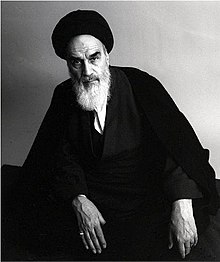
Back خمينية Arabic خومەینیزم CKB خمینیسم Persian Khomeinisme French ホメイニズム Japanese Khomeinism SIMPLE Khomeinism Swedish Humeynizm Turkish 霍梅尼主义 Chinese


| Part of a series on Islamism |
|---|
|
|
| Part of the Politics series |
| Republicanism |
|---|
|
|
Khomeinism, also transliterated Khumaynism, refers to the religious and political ideas and practices connected with the leader of the 1979 Iranian Islamic Revolution — Ruhollah Khomeini. While primarily referring to the ideas and practices of Khomeini himself, Khomeinism may also refer to the ideology of the clerical class which has ruled the Islamic Republic of Iran founded by Khomeini, following his death, and to the "radicalization" of segments of the Twelver Shia populations of Iran, Iraq, and Lebanon, and to the Iranian government's "recruitment" of Shia minorities in Afghanistan,[1] Pakistan,[2] Saudi Arabia,[3] and Africa.[4] The words Khomeinist and Khomeinists, derived from Khomeinism, can also be used to describe members of Iran's clerical rulers as opposed to "regular" (non-Wilayat ul-Faqih supporting) Shia Muslim clerics.
Under Khomeini's leadership, Iran replaced its millennia-old monarchy with a theocratic republic. Khomeini brought about a major paradigm shift in Shia Islam. He declared that Islamic jurists (clerics specializing in Islamic jurisprudence)[5] are the true holders of religious and political authority, who must be obeyed as "an expression of obedience to God",[6] and whose rule has "precedence over all secondary ordinances in Islam such as prayer, fasting, and pilgrimage".[7] Khomeini's doctrines would make a major influence on the landscape of Shia Islam; which had upheld political quietism for over a thousand years. Another significant revision of tradition was on Mahdism, the messianic belief in the reappearance of their Twelfth Imam and the proper way to wait for Him. Traditional Twelver theologians urged believers to wait patiently for his return, but Khomeini and his followers called upon Shia Muslims to actively pave the way for Mahdi's global Islamic rule.[8]
Since his death, politics in the legal sphere of the Islamic Republic of Iran has been "largely defined by attempts to claim Khomeini's legacy", according to at least one scholar, and "staying faithful to his ideology has been the litmus test for all political activity" there.[9] According to Vali Nasr, outside Iran, Khomeini's influence has been found among the large Shia populations of Iraq and Lebanon. In the non-Muslim world, Khomeini had an impact on the West and even Western popular culture where it was said that he became "the virtual face of Islam" who "inculcated fear and distrust towards Islam".[10]
- ^ Emadi, Hafizullah (6 December 2006). "Exporting Iran's revolution: the radicalization of the Shiite movement in Afghanistan". Middle Eastern Studies Journal. Vol. 31. pp. 1–12. doi:10.1080/00263209508701037. Retrieved 18 June 2021.
- ^ Alex Vatanka, Influence of iranian revolution in Pakistan: Security, Diplomacy Islamist Influence, I.B.Tauris (1989), pp. 148 & 155
- ^ Al-Rebh, Dr. Abdullah F. (29 March 2021). "Radical Shiism and Iranian Influence in Saudi Arabia". European Eye on Radicalization. Retrieved 18 June 2021.
- ^ Citrinowicz, Danny (16 June 2021). "Hezbollah and Iran's Radicalization Efforts in Africa". European Eye on Radicalization. Retrieved 18 June 2021.
- ^ Hamid, Shadi (4 October 2022). "The Reason Iran Turned Out to Be So Repressive". The Atlantic. Retrieved 21 January 2025.
- ^ Islamic Government Islam and Revolution I, Writings and declarations of Imam Khomeini, 1981, p.91
- ^ Hamid Algar Hamid Algar. "What Happens When Islamists Take Power? | The Case of Iran | Development of the Concept of velayat-i faqih since the Islamic Revolution in Iran,' paper presented at London Conference on wilayat al-faqih, in June, 1988 (p.135-8) Also Ressalat, Tehran, 7 January 1988". gemsofislamism.tripod.com.
- ^ Golkar, Aarabi; Saeid, Kasra (3 May 2022). "Iran's Revolutionary Guard and the Rising Cult of Mahdism: Missiles and Militias for the Apocalypse". Middle East Institute. Archived from the original on 1 June 2022. Retrieved 6 September 2023.
- ^ The New Republic "Khamenei vs. Khomeini" by Ali Reza Eshraghi, August 20, 2009, tnr.com dead link Archived 2009-08-21 at the Wayback Machine quotation from article Archived 2011-10-08 at the Wayback Machine accessed 9-June-2010
- ^ Nasr, Shia Revival, , 2006, p.138